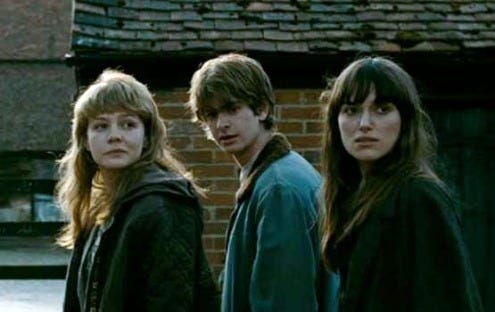Never Let Me Go
This commentary is part of an ongoing set discussing British films that you may have missed.

A fan of Kazuo Ishiguro’s book "Never Let Me Go" will enjoy director Mark Romanek’s handling of the story, plot, characters, relationships and messages portrayed in this film adaptation.
Romanek’s previous work making music videos and TV commercials meant the creation of a very distinctive vision for the film. The gentle color palette is perfectly matched to the somber, depressed state of this dystopian drama, where three people are entangled in a love triangle.
We learn there is much more to this initially simple premise, as Kathy (Carey Mulligan), Ruth (Keira Knightley) and Tommy (Andrew Garfield) are, without giving too much away, all scientific specimens with a future already mapped out for them.
Aside from 1985's "Static,"a small film shown at the 1986 Sundance Film Festival, Romanek has only directed one other major film, "One Hour Photo" (2002), starring Robin Williams as a photo developer who becomes obsessed with a family without them realizing. It shares the same quiet and contemplative atmosphere as "Never Let Me Go," but in a very different way and for different reasons. Seymour "Sy" Parrish (weirdly the same surname as Williams’ character in 1995's "Jumanji") is desperate and lonely, and Romanek’s direction is deliberate in the way that it reinforces this in every scene.
In 1993, Ishiguro’s "The Remains of the Day" also was adapted into a major film. Anthony Hopkins plays a butler who, after serving in World War II, realizes too late that his loyalties have been misplaced. This is not unlike "Never Let Me Go's" Ruth, who regrets a big mistake she once made and now faces the personal consequences of that decision, tying the two stories together with the theme of loneliness and the desperation that comes with it.
The beginnings of how "Never Let Me Go" was eventually made are unique. Real-life neighbors Ishiguro and Alex Garland (author of "The Tesseract" and screenwriter of "The Beach") frequently meet to bounce ideas off one another about their work. So excited was Garland about "Never Let Me Go's" themes and messages that he wrote a potential script for the film even before the book was published. Ishiguro’s perfect, elegant prose treads new territory into the realms of science fiction, something Garland handles with sensitivity in his screenplay.
The film is split into three sections representative of each part of the main characters' lives. The first details their time at a school named Hailsham, the second at the Cottages, a farmstead, and scenes in the final part of the film are set at a hospital called the Dover Centre. Scenes were mostly filmed on the east coast of England in Norfolk and opposite on the west coast in the small seaside towns of Weston-super-Mare and Clevedon. The beaches featured in the film are as desolate and bleak in real life, mirroring perfectly the lives and futures of the characters portrayed in it.
Mulligan and Knightley are perfectly cast as best friends Kathy, who narrates the film and acts as more of an observer, and Ruth, who is more passionate and impulsive than her quieter friend. Ruth is also in a relationship for part of the story with Tommy, a boy who's very confused with his difficult place in the world. Garfield, on being cast as Tommy, says he was attracted to the existential questions the story raises. This is not only a romantic love story, but a love story about the preciousness of family and the strength of the bond between Kathy and Ruth and how it fares in their unique circumstance.
Existentialism drenches every small plotline and relationship change between the three main characters, making this film so poignant and filled with emotion. It raises questions about being human and about the fundamentals of love, mortality and the ever-human fight to not be alone. It is not for the faint of heart and its powerful themes and beautiful filmmaking will leave you in a somber state for hours afterward.
Previous British film commentaries:


